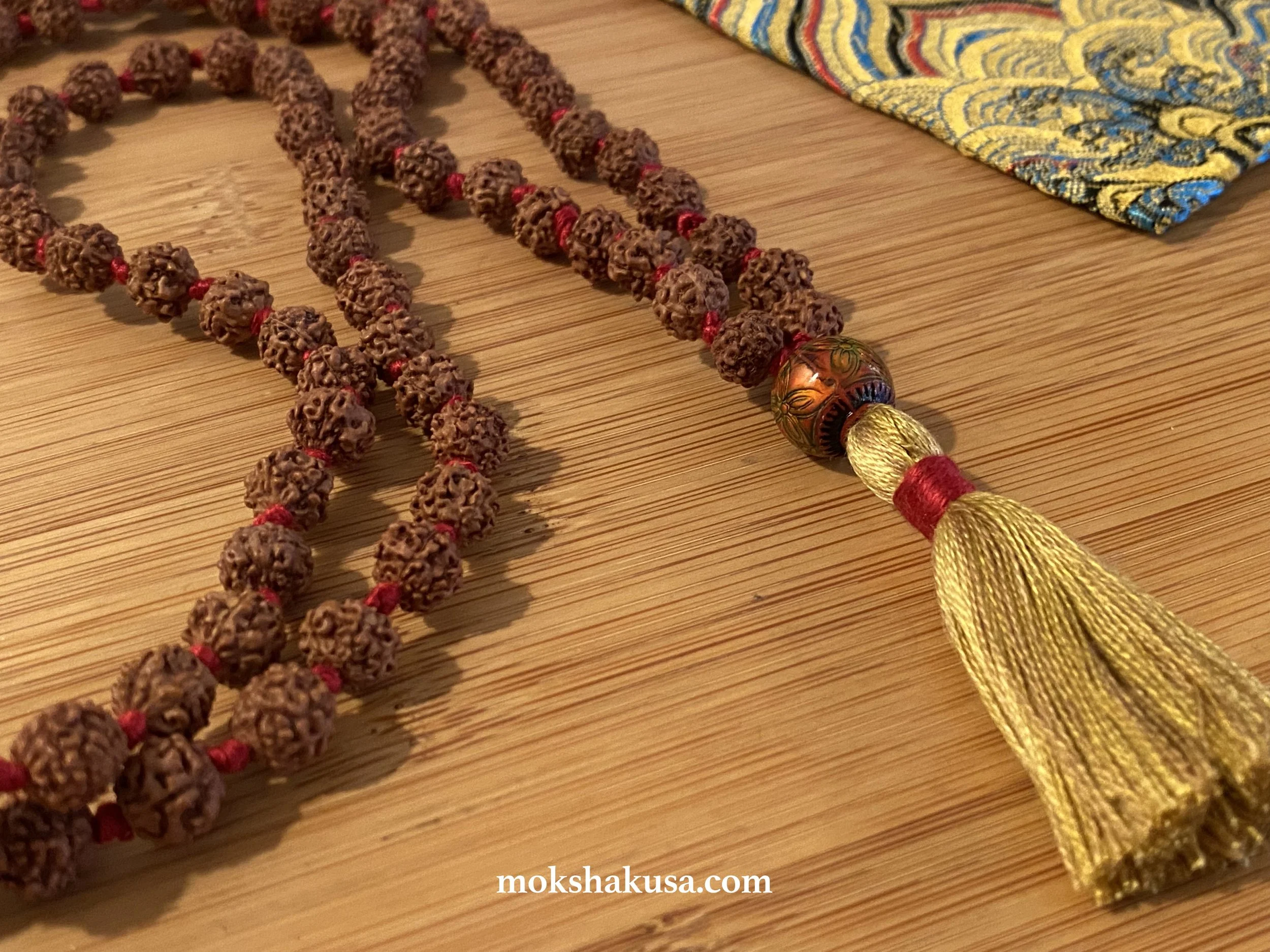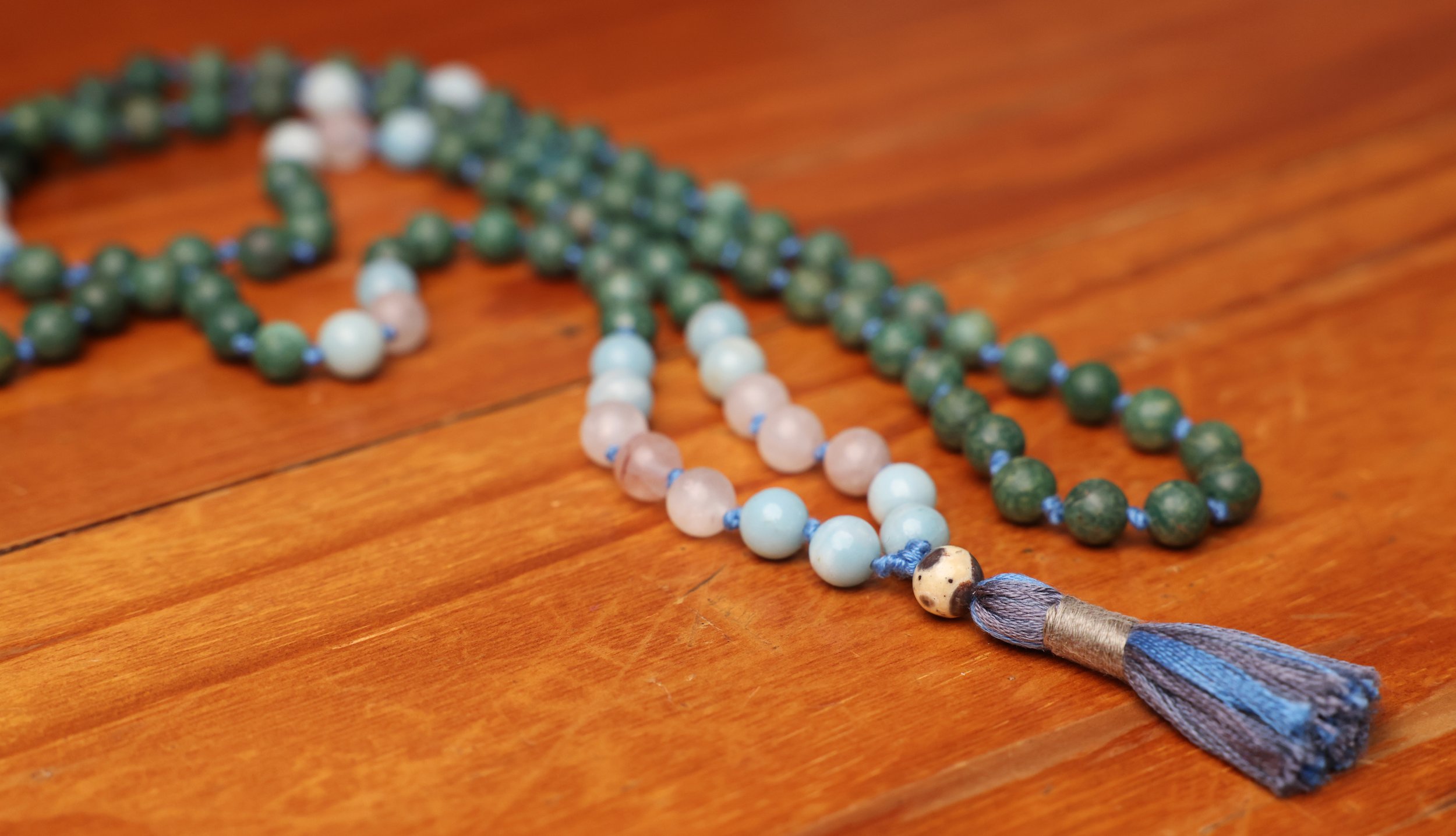Making a Mala: The Ritual of Tying and Untying Knots
I started making malas around the start of 2021. My partner gave me one for Christmas and I really liked it as a tool. But it seemed to me that the best mala to use for prayer would be one that I made myself. I mean, how hard could it be…and so I set out to learn how to make my own.
I had just started chanting mantra and was also enjoying a new awareness of the world of kirtan. On top of that I had started painting the deities (Ganesha, Hanuman, Shiva, Lakshmi). All these things compounded was giving me a special appreciation for the mala as a sacred spiritual tool with an enormous history. Plus, there’s a lot of creative choices that go into making a mala, like which gems and seeds to use and what color of cord to use. I love the idea of a creative project that yields a functional work of art.
A lovely mala made from moss agate, labradorite and amazonite with an amethyst guru bead
The first thing I did was go to the university of YouTube and start watching videos. It turns out there are a bunch of ways people like to make malas, and they have some pretty funky ways they like to tie knots! The act of tying a knot is the most important part of making a mala and it had to be right. The tying of the knots is a ritual and should be done with focus while chanting a mantra. However, none of these initial YouTuber knots were working for me and the only thing I was chanting were four-letter-words. The results were sloppy, uneven and not fit for a mala.
The hardest part in mala making is getting the knot snug against the bead without a gap and I wasn’t able to do that with any certainty. Secondly the thickness of the cord can be a major issue, mine was too thin and I was getting knots that were too small which allowed the bead to slide over them. There had to be a better, more “official” way to make one.
A mala using the traditional rudraksha seeds
I joke that it was harder to learn to tie the traditional mala knot, called Brahmagranti, then it was to change the carburetor in my Honda Element (which I also learned on YouTube). Thankfully I eventually came across a video by an Irish monk who said he had been making a mala a day for more than 20 years! It was his process that I finally adapted, but not without a struggle. For some reason, following his hands in the video as he tied the knots was maddening. I couldn’t get it. I tried and tried and then I gave up for awhile…then came back to it a month later and finally figured it out. With a little practice I was able to create a mala that was pretty attractive and I was able to consistently get the knot snug against the bead. But every once in awhile there comes a knot, that is NOT what you were hoping for!
Early in my practice I learned the necessity of patience. The first time I tied a bad knot I was unwilling to accept it as such and was determined to fix it. I would find myself working a ragged knot of cotton embroidery thread using a needle and tweezers and with the aid of magnifying goggles, for what felt like an hour. Are you familiar with embroidery thread? A strand is made up of six tiny fragile stands. The way I make these, the cord is doubled up so you have two strands of six tiny threads each, tied into a tight knot. In the process of undoing one of these nightmare knots, if you break even one of these tiny 12 strands your mala is finished and you have to cut it all up and start over. I can be stubborn and unwilling to give up and so I have spent more than 20 minutes or so, three inches from a tangled mess, staring with focused determination into the chaos of an unruly knot. When I’m 106 knots into a 108-bead mala and a knot unexpectedly goes bad (there’s a million ways this can happen), I’m going to find a way to untie it! Failure is not an option.
A simple mala using sandalwood, mookalite and pyrite.
There is a deeper lesson here actually. As I said earlier, the ritual of tying the knot is the whole point of making this sacred tool. And so it goes that the untying of a knot also carries important lessons in patience, focus, determination and above all, anger management!
There was one time when I was making a mala, probably my 50th or so, and I was well into the process when something happened unexpectedly. Even though I was at full attention, the knot bunched up and was suddenly a terrible mess. I was angry at myself at first for not paying attention but then I recognized that actually I was paying attention, and that this disaster was not my fault. I then went into a meditation as I worked for the next 30 minutes or more to untie the knot that refused to be untied. The longer I spent on it the worse the situation seemed to become, it was getting worse and that just made me more determined. I had finally met my match. I recognized that I could have become very angry but that wasn’t going to serve me, and who or what would I direct that anger at? I was here now with a problem and I wanted to save my mala. Take a deep breath…
A mala with a unique guru bead
If I thought I was wasting time with untying the knot I would be missing the point. The whole process is the ritual, including these unexpected little disasters. In this one unruly knot I saw the full light and the sacredness of this ancient practice of mala making. And so I’m grateful for that experience as a teacher.
I’ve probably made sixty or so malas now and I still tie bad knots once in awhile and so far I have never had to scrap a mala and start over. Not yet…
If you enjoyed this story please leave a comment below. Or maybe you have a similar story to share.
You can also browse my current selection of malas for sale, or commission a special one. Thanks for reading!
Also, if you're interested in learning how to make your own mala, I just posted a how-to video to my YouTube which walks you through the entire process!





